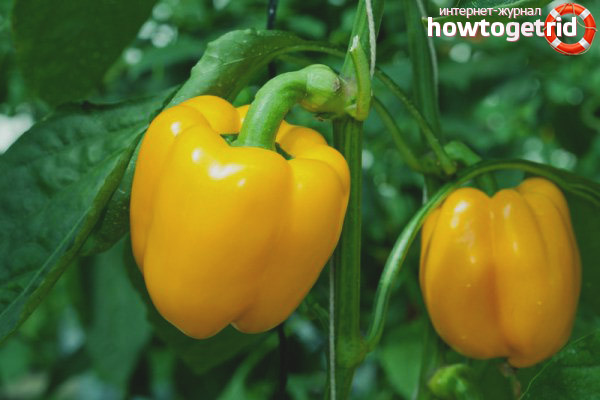The content of the article
An early ripe variety is grown in greenhouses and open ground. It was created for regions with large differences in day and night temperatures, sudden frosts and arid summers. Pepper stably gives a plentiful harvest even under adverse conditions, deserving resistance of gardeners who annually choose it for planting on a personal plot.
Grade characteristics
For the first time, culture appeared in the vast country at the end of the 18th century. Interest in him increased gradually, in accordance with how expanded the scope of its application. Now it is difficult to imagine a mistress who would not know some delicious recipes from a family piggy bank based on bell pepper.
To have it on hand in the hot season of harvesting, you do not need a huge plantation. The yield of the Yellow Bell is 8 kg. with 1 sq. m., therefore, a fairly small bed with healthy strong plants, and a delicious adjika or aromatic lecho, complex marinades and winter vitamin salads will be provided with the necessary ingredient.
Plants of this variety are mid-growth, reaching 75 cm in height. When grown in a greenhouse, taller specimens are possible. He received the name for the similarity of fruits with inverted bells. They also expand to the peduncle, forming an almost regular cone. The weight of especially large specimens reaches 200 g, the average figure is kept at the level of 100-130 gr. The walls are of medium thickness, slightly ribbed, therefore very convenient for stuffing and pickling in general. In general, the grade:
- resistant to adverse conditions;
- tolerates transplantation;
- forms a friendly ovary;
- gives a plentiful harvest;
- the fruits are resistant to transportation and storage;
- not prone to typical nightshade disease.
Features and Benefits
The main sign of the variety was a bright saturated yellow color, indicating an increased content of vitamin C and carotene.
Important: a color that does not contain red tones indicates a lower allergenicity of the product compared to other species.
The benefits include:
- unpretentiousness to conditions;
- ovary formation in rainy cool weather;
- the possibility of growing in greenhouses and in an open way;
- high resistance to tobacco mosaic.
These features greatly facilitate the cultivation of pepper in regions with difficult climates.
The subtleties of care
When composing a planting scheme, one must take into account that pepper does not tolerate the neighborhood with potatoes and eggplant. Planting seedlings on last year's beds of these crops is also not worth it. They belong to the same species, diseases and requirements for the composition of the soil they also coincide. It is more useful to apply alternation with pumpkin, garlic, onions, beets, beans and peas.
Watering is carried out 2-3 times a week under the root, excluding the ingress of water on the leaves. Top dressing is necessary according to a certain scheme, including the alternate application of complex and organic fertilizers, such as ash and mullein solution.
You should know: pepper is susceptible to pests.Aphids, fleas, bear, nematodes, spider mites, slugs, earwigs spoil fruits, leaves, damage roots. For timely assistance to plants, it is necessary to carefully examine them 1-2 times a week in the morning, before the onset of heat, carry out preventive treatment, sprinkle the edges of the beds with sand mixed with hot pepper powder to block the path to juicy fruits.
Peppers are used in a fresh, pickled, canned form. After harvesting, store in a cool dark place.
Video: growing pepper from A to Z










Submit